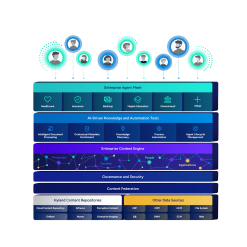Artificial intelligence (AI) and data capture: An evolution of efficiency
From Siri and Alexa to customer service chatbots, artificial intelligence (AI) has fundamentally changed many aspects of the way we work — and data capture is no exception.

Harness the power of a unified content, process and application intelligence platform to unlock the value of enterprise content.
Learn more
Automate your document-centric processes with AI-powered document capture, separation, classification, extraction and enrichment.
Learn about Hyland IDPIt's your unique digital evolution … but you don't have to face it alone. We understand the landscape of your industry and the unique needs of the people you serve.
 Overview of industries
Overview of industries
Countless teams and departments have transformed the way they work in accounting, HR, legal and more with Hyland solutions.
 Overview of departments
Overview of departments
We are committed to helping you maximize your technology investment so you can best serve your customers.
 Overview of services
Overview of services

Learn proven strategies, connect with experts, innovate boldly
Register for CommunityLIVE 2026 today
Our exclusive partner programs combine our strengths with yours to create better experiences through content services.
Overview of partners
Join The Shift newsletter for the latest strategies and expert tips from industry leaders. Discover actionable steps to stay innovative.
Register now
Hyland connects your content and systems so you can forge stronger connections with the people who matter most.
Learn about HylandWith our modern, open and cloud-native platforms, you can build strong connections and keep evolving.
 Dig deeper
Dig deeper
Automated data capture technology already increases workplace efficiency and decreases business costs. “Intelligent” capture takes it to another level, leveraging the power of AI and robotic process automation (RPA) to create a partnership that delivers even greater benefits.
Imagine feeding a batch of invoices into a scanner, stepping away and letting an attached computer both file and prepare them so you only thing you need to deal with are the exceptions.
Truly intelligent capture software doesn’t require templates, keywords, exact definitions, taxonomies or indexing to get the job done.
It extracts the right information and makes sense of a wide variety of documents on its own, regardless of size, format, language or symbols used.
With intelligent capture software, the AI-driven “engine” can be taught — exactly like a new employee — how to perform a data entry task.
It can quickly pick up on contextual information and learn to interpret patterns and features in different document types.
Moreover, it can validate data against existing systems, providing an additional layer of protection that employees can’t duplicate without tedious manual lookups.
Intelligent data capture has changed the game for three major tasks: classification, extraction and validation.
With classification, also known as document sorting, the software learns to recognize different types of documents after the user gives it a few variations and examples.
Just like a human, the software can read through sample documents and intuitively understand similarities and differences. The machine learning engine cuts down on the rules that need to be applied, resulting in a high level of confidence in document classification with minimal manual effort.
AI has done wonders for data extraction in semi-structured and unstructured documents.
For instance, take invoice number identification, which usually involves building out complex templates and providing keyword tags and pairings around particular fields and labels.
A new employee can look at a document and immediately locate where invoice numbers are, no matter what the form looks like.
Intelligent capture software can do that too — without the need for programming.
The machine learning engine is trained to understand context: Like what should (or shouldn’t) be around the invoice number. This leads to a high degree of accuracy in the extraction.
Additionally, extracting data from complex stacked tables, with lines that don’t match up (i.e. transcripts) is now a breeze.
Mature AI software learns how to understand patterns and formatting, look for different types of information and identify key data elements without the need for someone to rope and band the information. Only the exceptions require human intervention.
AI is a game changer for tasks that go beyond the “scrape-the-page” approach. For example, it can match a line item in an invoice with purchase information stored in another system.
AI-driven search also allows for multi-way search, which means it can use multiple pieces of information (i.e. quantity, price, description and amount) to match an exact item in the back-end system.
Even if things aren’t precise matches — say, an abbreviation is used in the description of the invoice, but not the back-end system — the software can deduce they are the same item.
Validating precise matches once required the efforts of a patient data entry clerk.
By minimizing this type of work, employees can now work on higher-value tasks, further driving efficiency and minimizing business costs.
Learn more | Business process management
The enterprise RPA market is booming. Unfortunately, RPA’s processes fail when there’s too much variance — and with documents, sometimes there is nothing but variance.
For instance, if two documents have the same type of information but are not in the same exact template, optical character recognition (OCR) errors occur.
Combining standard RPA concepts with an AI engine creates a dynamic variance network — a way for software to look at everything in relation to all information on a document.
That way, it overcomes OCR errors during the extraction process by using relative location to determine where to find a specific data field instead of a single, memorized location.
On top of that, the software monitors the activity of the user and will make corrections based on that behavior without human intervention. In other words, the system gets smarter on its own.

In addition to the obvious automation benefits, using intelligent data capture software eliminates guesswork on the setup and programming side.
But it’s important to note that the goal of AI-driven data capture isn’t to replace humans, but to drive as much automation as possible with machines that can intelligently carry out tasks.
Ultimately, employees are freed from being bogged down by mundane tasks and can take on high-value tasks that require a human mind to be done well.
